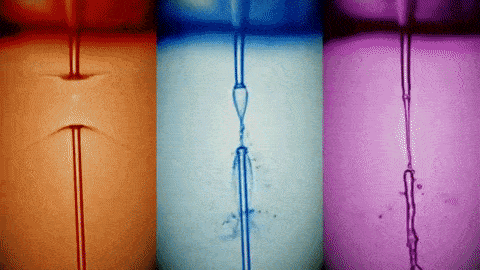
Stanford researchers fired extremely bright flashes of light from the world’s most powerful X-ray laser onto droplets of liquid. These vaporized instantly, but not before the whole process was imaged in full detail. The work will help researchers make better X-ray experiments since they can better understand how liquids from sample explode when illuminated by the lasers.
Claudiu Stan of Stanford PULSE Institute and colleagues injected liquid into the path of the X-ray laser in two ways: as individual droplets and as a continuous jet.
After each pulse hit the sample, an image was taken. That’s every five billionths of a second to one ten-thousandth of a second. The images were then stitched together into movies.
“Thanks to a special imaging system developed for this purpose, we were able to record these movies for the first time,” says co-author Sébastien Boutet from LCLS. “We used an ultrafast optical laser like a strobe light to illuminate the explosion, and made images with a high-resolution microscope that is suitable for use in the vacuum chamber where the X-rays hit the samples.”
When the lasers hit a droplet, these are ripped apart. As seen in the footage, a cloud of smaller particles and vapor is generated which expands damaging the neighboring drops. The damaged drops then merge with the nearest drops. As for liquid jets, the X-ray pulse initially plugs a hole in the stream. The gap then expands, all while the ends of the jet on either side of the gap form a thin liquid film. The film eventually turns into an umbrella shape before finally folding back and merging with the jet. The videos also show for the first time how X-rays create shock waves that rapidly travel through a liquid jet. This is important because these shockwaves can be used to probe materials.
Based on these experiments, the Stanford team made a mathematical model which can predict how liquids behave in similar conditions when exposed to the powerful X-ray lasers, as reported in Nature Physics.
“Understanding the dynamics of these explosions will allow us to avoid their unwanted effects on samples,” says Stan. “It could also help us find new ways of using explosions caused by X-rays to trigger changes in samples and study matter under extreme conditions. These studies could help us better understand a wide range of phenomena in X-ray science and other applications.”
“The jets in our study took up to several millionths of a second to recover from each explosion, so if X-ray pulses come in faster than that, we may not be able to make use of every single pulse for an experiment,” Stan says. “Fortunately, our data show that we can already tune the most commonly used jets in a way that they recover quickly, and there are ways to make them recover even faster. This will allow us to make use of LCLS-II’s full potential.”


